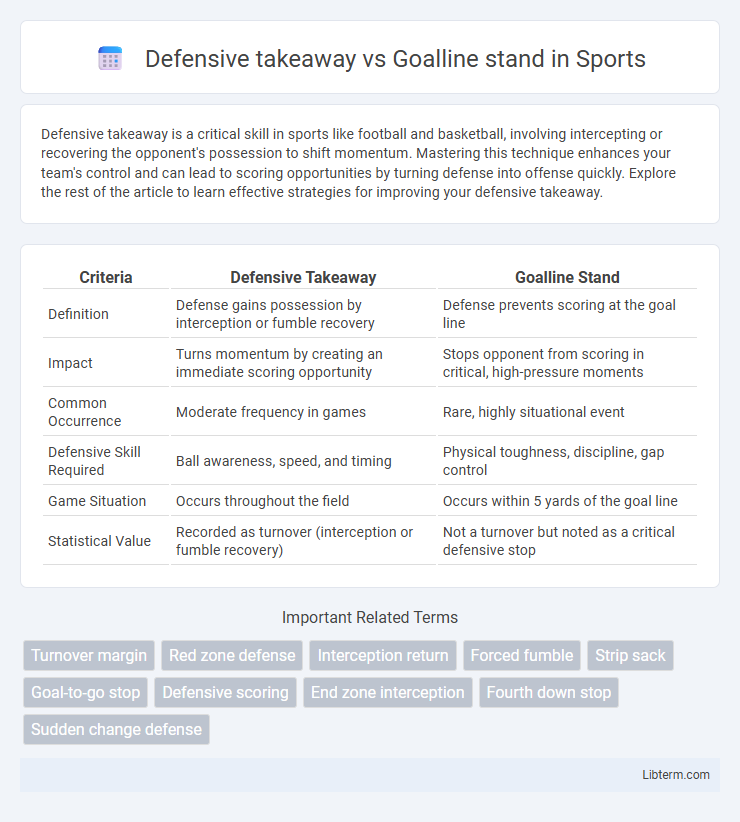Defensive takeaway is a critical skill in sports like football and basketball, involving intercepting or recovering the opponent's possession to shift momentum. Mastering this technique enhances your team's control and can lead to scoring opportunities by turning defense into offense quickly. Explore the rest of the article to learn effective strategies for improving your defensive takeaway.
Table of Comparison
| Criteria | Defensive Takeaway | Goalline Stand |
|---|---|---|
| Definition | Defense gains possession by interception or fumble recovery | Defense prevents scoring at the goal line |
| Impact | Turns momentum by creating an immediate scoring opportunity | Stops opponent from scoring in critical, high-pressure moments |
| Common Occurrence | Moderate frequency in games | Rare, highly situational event |
| Defensive Skill Required | Ball awareness, speed, and timing | Physical toughness, discipline, gap control |
| Game Situation | Occurs throughout the field | Occurs within 5 yards of the goal line |
| Statistical Value | Recorded as turnover (interception or fumble recovery) | Not a turnover but noted as a critical defensive stop |
Understanding Defensive Takeaways
Defensive takeaways are critical moments when the defense forces a turnover by recovering a fumble or intercepting a pass, directly shifting momentum and providing their offense with advantageous field position. Unlike goalline stands, which occur near the defender's goal line to prevent scoring, takeaways can happen anywhere on the field and often lead to scoring opportunities for the defense or offense. Mastering defensive takeaways requires anticipation, quick reaction, and disciplined tackling to disrupt offensive plays and capitalize on opponents' mistakes.
What Defines a Goalline Stand
A goalline stand is defined by the defense preventing the offense from crossing the goal line within the final yards, usually inside the 5-yard line, during critical moments of the game. It requires a disciplined defensive unit to stop powerful runs or short passes, preserving the score and momentum for their team. Unlike a generic defensive takeaway that includes interceptions or fumble recoveries anywhere on the field, a goalline stand specifically protects against a touchdown in the red zone.
Comparing Defensive Takeaways and Goalline Stands
Defensive takeaways create momentum shifts by forcing turnovers, often leading to scoring opportunities and disrupting offensive rhythm. Goalline stands demonstrate defensive resilience by preventing touchdowns in critical red-zone situations, showcasing strategic positioning and tackle execution. Both highlight defensive prowess, but takeaways change possession and game flow, while goalline stands focus on damage control in high-pressure moments.
Key Strategies for Forcing Takeaways
Defensive takeaway strategies emphasize aggressive ball pursuit, tight coverage, and creating turnover opportunities through strip tackles and interceptions. In contrast, goalline stands rely on stifling offensive progress with compact formations, gap control, and disciplined tackling near the end zone. Key tactics for forcing takeaways include reading the quarterback's eyes, anticipating routes, and leveraging relentless pressure to disrupt ball security.
Techniques Behind Successful Goalline Stands
Successful goalline stands rely on a combination of disciplined defensive formation, precise gap control, and explosive tackling techniques to prevent the offense from crossing the goal threshold. Defensive players employ strategic leverage and low pad level to disrupt blocking schemes and create penetration, forcing short-yardage failures. Mastery of read-and-react principles and communication enables defenders to anticipate play direction, optimizing team effort in high-pressure, goal-line scenarios.
Impact of Takeaways on Game Momentum
Defensive takeaways drastically shift game momentum by forcing turnovers and creating scoring opportunities, often leading to immediate points or advantageous field position. Goalline stands halt the opposing team's scoring drive at a critical moment, preserving the lead and energizing the defense. Both plays significantly influence team morale and can determine the game's outcome by controlling the flow and psychological edge during high-stakes situations.
Goalline Stands: Turning Points in Tight Games
Goalline stands represent critical defensive moments where a team prevents an opponent from scoring at the goal line, often altering the momentum of tight games. These defensive efforts showcase disciplined tackling and strategic positioning, frequently resulting in pivotal turnovers or stops that shift field position. Successful goalline stands can energize a defense, boost team morale, and ultimately determine the outcome in closely contested matchups.
Famous NFL Defensive Takeaways
Famous NFL defensive takeaways, such as Malcolm Butler's interception in Super Bowl XLIX, showcase critical moments that shift game momentum and secure victory. Defensive takeaways often determine outcomes by halting offensive drives and creating scoring opportunities, exemplified by Richard Sherman's game-sealing interception in Super Bowl XLVIII. Unlike goalline stands that primarily prevent scoring near the endzone, defensive takeaways create game-changing turnovers across the field.
Legendary Goalline Stands in Football History
Legendary goalline stands in football history showcase the ultimate display of defensive resilience, often involving critical defensive takeaways that prevent opponents from scoring at the brink of the end zone. Iconic moments, such as the 2006 Chicago Bears vs. New Orleans Saints game, highlight defenders stripping the ball or intercepting passes mere inches from the goal line, preserving victories and altering season trajectories. These pivotal defensive plays epitomize teamwork, strategic execution, and the relentless fortitude that define the sport's most memorable defensive stands.
Choosing the Right Defensive Approach
Choosing the right defensive approach involves evaluating the situational context, such as field position and down-and-distance, to decide between a defensive takeaway and a goal line stand. Defensive takeaways prioritize forcing turnovers through aggressive blitzes or ball-hawking strategies, aiming to shift momentum by recovering fumbles or intercepting passes. Goal line stands focus on tight, disciplined leverage and gap control near the end zone, using strong front seven play to prevent short-yardage touchdowns.
Defensive takeaway Infographic

 libterm.com
libterm.com